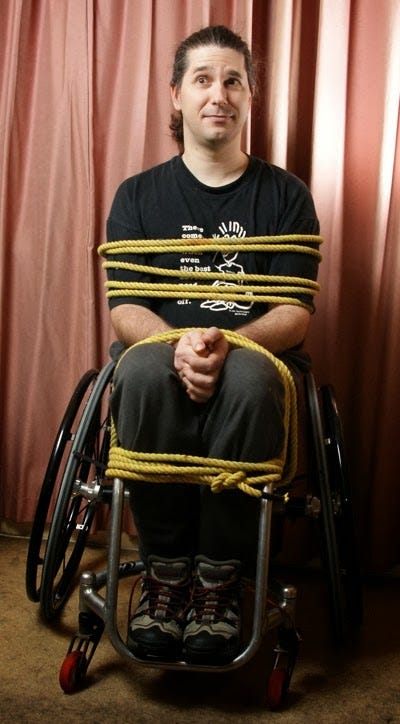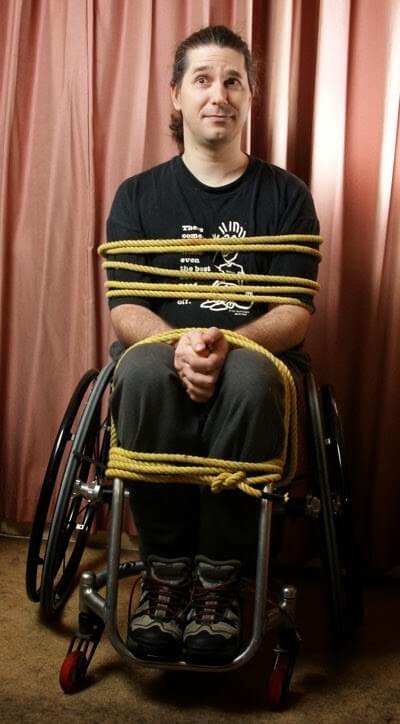The phrase is still in widespread use and needs to be banished, just like the “r” word

If you’re not disabled and you don’t have the lived experiences of your colleagues with disabilities, there’s a non-zero chance you’re going to make a communications mistake. Communication mistakes are incredibly common when you add cultural and geographic differences.
Just like awareness around inclusive language impacting the LGBTQ+, gender, and PoC communities, there is a massive difference between impact and intent in inclusive language for people with disabilities.
- Most people who make errors in inclusive language use measure their actions by intent — Here is a real example that happened to me six months ago. A senior leader in HR at my company at a leadership event did a Quasimodo hunchback pose with an exaggerated limp to make a point that was not related to disability. When I called him on it, he said, “I didn’t mean it to be offensive.” I hear that — a lot. Having a significant kyphosis (the medical term for “hunchback”) myself and walking with a limp (when I do walk), the statement impact was I felt like he was making fun of people with disabilities. It was demoralizing, to say the least, because it came from someone important. From HR. At a fricking LEADERSHIP event! I actually excused myself, went to the bathroom, and cried. About four hours later, after he had time to process, he did come back and apologized and acknowledged the intent/impact disparity.
- The recipients of the exclusive language measure the action by impact. The impact of using an imitation of Quasimodo to make a negative point less than 10 feet away from someone in a wheelchair really cannot be disputed. Using the phrase “wheelchair-bound” in my presence, as thick as my skin is, is received as a microaggression. I am not “tied to” or “stuck in” my wheelchair. My wheelchair is merely a way that gets me from “Point A” to “Point B”, because my legs don’t work as well as they are supposed to.
The first time a disability-language mistake is made, I forgive and forget. It’s a teachable moment, and especially with people who know me well, it rarely happens again.
When the microaggression repeats frequently, however, it becomes less forgivable and more an objective demonstration of the speaker’s lack of self-awareness and privilege.
How do you avoid this issue
DO THE WORK !!! Don’t expect someone with a disability to hold your hand to lead you to be more inclusive. Like BIPOC, people with disabilities are tired — -there are way more of you (especially in the workplace), and relatively few of us. Employed people with visible disabilities represent about 1 % of the average mid-sized or large company. And that’s for companies who are doing a good job. We’ve struggled for a long time, and still have a long way to go with respect to progress to true equality. To this day, many with hidden disabilities choose not to bring their authentic selves to work.
We want allies to educate THEMSELVES. There are many non-onerous things that individuals can do to be aware of their language choices related to disability. Following these steps will make yourself a better disability ally, and anti-ableist:
- Ask yourself, “why was the person uncomfortable with what I said?” Sometimes it will be pointed out to you, more often it is not. When you hear silence in the room, that is the time to think about what you said. Google it, or ask someone you trust, preferably someone who was present. When you retell the story, it is natural to want to present yourself in the best light possible, and that may not be what happened.
- Recognize that “positive” comments can also trigger disability microaggressions. Telling someone with a chronic illness that they are brave, strong, or tough can be received as a microaggression. You (the non-disabled ally) think of that as a compliment (intent). But it may not be received that way (impact) because many of us are tired of hearing it and don’t believe it ourselves. Most of us feel that we just have to slog through it, and being reminded that our lives are viewed as difficult by others can be a trigger.
- Explore your self-awareness. Where did your unconscious bias against disabilities come from? And before you say you don’t have one, or you can’t have one because you have a disability yourself — stop. That isn’t true. EVERYONE has an unconscious bias towards disabilities that has to be overcome at some point in time in our lives. I do not except myself from that statement. Did you grow up without exposure to people with disabilities? Are disabilities viewed as unfavorable in your geographic area or culture? Think you aren’t biased? Take the Harvard implicit bias test for disabilities.
- Undertake activities make you woke about disability — meetups, social media groups, disability cultural centers, volunteering. There are many things you can do related to disability that will show you over time that people with disabilities really are just like everyone else, they just occasionally have to do things differently.
- Read books authored by disabled people like Judy Heumann (Being Heumann: An Unrepentant Memoir of a Disability Rights Activist), and Haben Girma (Haben: The Deafblind Woman who Conquered Harvard Law). While you are at it, make sure you watch CripCamp on Netflix.
Done the hard work? Awesome. The reward for doing the hard work is more hard work.
Do something with your newfound knowledge. Don’t rest on your laurels that you are the best disability ally out there. Make everyone around you 10 % more impactful in their disability allyship.

0 comments on “What one wheelchair user thinks about being called “wheelchair-bound””